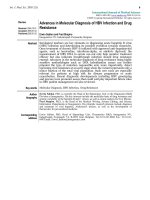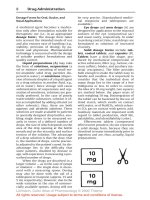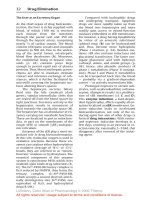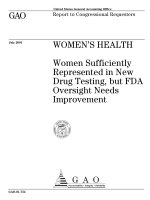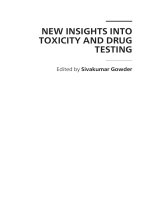neonatogist poket drug 2015
Bạn đang xem bản rút gọn của tài liệu. Xem và tải ngay bản đầy đủ của tài liệu tại đây (4.19 MB, 185 trang )
Keynotes
Pediatric Series
Neonatologists’
Pocket
Drug
Reference
6thedition
2015
Neonatologists’ Pocket Drug Reference
Cobyright © 2015 by Maged Zakaria Mahmoud Ali IBRAHIM
All rights reserved. No part of this publication may be
reproduced or transmitted in any form or by any means,
electronic or mechanical, including photocopying, recording, or
any
information
storage
and
retrieval
system,
without
permission in writing from the author. Queries on how to seek
permission, and arrangements can be sent to the author’s
email:
Knowledge and best practice in this field are constantly changing. As new research and
experience broaden our understanding, changes in research methods, professional
practices, or medical treatment may become necessary. Practitioners and researchers must
always rely on their own experience and knowledge in evaluating and using any
information, methods, compounds, or experiments described herein. In using such
information or methods they should be mindful of their own safety and the safety of others,
including parties for whom they have a professional responsibility. With respect to any drug
or pharmaceutical products identified, readers are advised to check the most current
information provided (i) on procedures featured or (ii) by the manufacturer of each product
to be administered, to verify the recommended dose or formula, the method and duration
of administration, and contraindications. It is the responsibility of practitioners, relying on
their own experience and knowledge of their patients, to make diagnoses, to determine
dosages and the best treatment for each individual patient, and to take all appropriate
safety precautions. To the fullest extent of the law, the author does not assume any liability
for any injury and/or damage to persons or property as a matter of products liability,
negligence or otherwise, or from any use or operation of any methods, products,
instructions, or ideas contained in the material herein.
ماجــد زهريا محمـود عـلى ابراهيـم. د٥١٠٢ © حلوق الطبع محفوظت
ًحغس هلل أو وسخ أو اكخباض بعع أو كل ألافكاز أو الجداول أو طسٍلت الظسد الوازدة في، جمُع الحلوق محفوعت للمؤلف
مخالفت ذلك ٌعسض للمظائلت اللاهوهُت، هرا الكخاب
يتم طلب الىتاب داخل أو خارج مصر عً طريم املؤلف
www.facebook.com/keynotes.pediatrics
Acknowledgement
This Egyptian Neonatal Pharmacopoeia started life in 2008 as loose A5
reference papers of the commonly used drugs in the neonatal intensive care
unit at the Ain Shams University Maternity Hospital in Cairo, Egypt. It has been
updated many times since then and has expanded considerably, but the format
and the basic layout had not changed.
The 2015 new format and layout reflects the accumulated experience of
the unit, the developments in neonatal medicine, and provids up-to-date
information about the use of drugs in the neonatal period and shortly beyond.
The book is now available in an electronic pdf formats including an index
with direct hyperlinks. Many related reviews and clinical trial are provided as
direct links to files on Dropbox™. Regular updates will be posted on the series’
Facebook page (Keynotes.Pediatrics).
I’d like to deeply thank all the professors, consultants, colleague doctors,
pharmacists, nurses and others who made a significant contribution to the
preparation of this book.
Maged, 2015
References
Index with hyperlinks
A
A-viton
Abimol
Acetaminophen
Acetazolamide
Acetylcistein
Acetylcysteine
Actrapid
Acyclovir
Addamel N
Adenocor
Adenosine
Adrenaline
Albumin, human
Albuterol
Aldactone
Alfacalcidol
Alfacareno
Ambroxol
Amikacin
Amikin
Aminophylline
Amiodarone
Amphotericin
Ampicillin/Sulbactam
Antodine
Apresoline
Aptamil 1
Astonin-H
Atracurium
Atropine
Atrovent
Augmentin
Averozolid
Azithromycin
B
B-com
Bebelac 1
Bebelac EC
Bebelac FL
Bebelac premature
Bebe-vit
Bécozyme
Benzoate, sodium
Beractant
Bicarbonate, sodium
Biotin
Breast Milk
Brufen
Budesonide
Bumetanide
C
Caffeine Citrate
Caffeinospire
Calcium Chloride
Calcium Gluconate
Calcium, oral
Capoten
Captopril
Ceclor
Cefaclor
Cefazolin
Cefdin
Cefdinir
Cefepime
Cefobid
Cefoperazone
Cefoperazone/Sulbactam
Cefotaxime
Cefpodoxime
Ceftazidime
Ceftriaxone
Cetal
Chloral Hydrate
Cidamex
Ciprofloxacin
Claforan
Clarithromycin
Clexane
Clindamycin
Co-Amoxiclav
Coenzyme Q10
Colimex
Colistin Sulphate
Cordarone
Cortilon
Co-trimoxazole
Curosurf
Cyklokapron
Cymevene
D
Daktarin
Dalacin-C
Debocaine
Decadron
Decal-B12
Dentinox
Devarol-S
Dexamethasone
Diamox
Diazepam
Diflucan
Digibind
Digoxin
Digoxin immune Fab
Dimethicone
Dobutamine
Dobutrex
Domperidone
Dopamine
Dormicum
Dornase alfa
E
Edemex
Eltroxen
EMLA
Enoxaparin sodium
Epanutin
Epicephin
Epinephrine
Epival
Epoetin alpha
Eprex
Erec
Erythrocin
Erythromycin
Esomeprazole
Euvax B
F
Famotidine
Farcolin
Fentanyl
Ferose
Filgrastim
Flagyl
Flebocortid
Fluconazole
Fludrocortisone
Folic Acid
Folicap
Fortum
Fungistatin
Fungizone
Furosemide
Insulin, short-acting
Intralipid
Ipanten
Ipratropium Bromide
Iron
Isoniazid
IVIG
G
G-CSF
Ganciclovir
Garamycin
Gastrazole
Gaviscon
Geneleukim
Gentamicin
GlucaGen HypoKit
Glucagon
Glypressin
L
Lanoxin
Lanzoprazole
Lanzor
Lasix
L-Carnitine
Levophrine
Levothyroxine
Lidocaine
Linezolid
Liometacen
Lipid Emulsion
Lipovenös
LMWH
Longacef
Losec
H
Hepabig
Heparin
Hepatitis B Globulins
Hepatitis B Vaccine
Hero Baby 1
Hical
Hyalase
Hyaluronidase
Hydralazine
Hydretic
Hydrochlorothiazide
Hydrocortisone
Hydroferrin
I
Ibuprofen
Imipenem/Cilastatin
Inderal
Indomethacin
Infatrini
Injectmol
K
Kapron
Kayexalate
Klacid
Klarimix
Konakion MM
M
Magnesium Sulphate
Maxical-D
Maxipime
Mayestrotense
Meronem
Meropenem
Metronidazole
Miconaz
Miconazole
Midathetic
Midazolam
Milrinone
Minophylline
Morphine Sulphate
Motinorm
Mucosolvan
Mycostatin
N
Naloxone
NAN 1
Narcan
Neocate
Neomaint
Neostigmine
Nestogen
Neupogen
Neuril
Nexium
Noradrenaline
Nystatin
O
Octagam
Octreotide
Omeprazole
One-Alpha
Orazone
Orelox
P
Paracetamol
Paramol
Pediamaint
Perfalgan
Phenadone
Phenobarbital
Phentolamine
Phenytoin
Phytomenadione
Phytovit
Piperacillin/Tazobactam
Polyvit
Polyvital
Poractant alfa
Potassium Chloride
Potassium M
Primacor
Primavita 1
Propranolol
Prostaglandin E2
Prostin-VR
Protam
Protamine Sulfate
Pulmicort
Pulmozyme
Pyral
Pyridostigmine
Pyridoxine
R
Rancif
Ranitidine
Riboflavin
Rifampicin
Rifocin
Rimactane
Rimactazid
Ringer’s Lactate
Risek
Rociphen
Rogitamine
Rogitine
S
S-26 AR
S-26 Gold
S-26 HA
S-26 PDF GOLD
Salamol
Salbovent
Salbutamol
Salurin
Sandostatin
Septrin
Sigmacyn
Sildenafil
Simethicone
Similac NeoSure
Slowapresoline
SMOFlipids
Solu-Cortef
Soluvit N
Sorbisterit
Spironolactone
Sterogel “H”
Stesolid
Sulbin
Sulfamethoxazole
Sominaletta
Sulperazon
Survanta
Sutrim
T
Targocid
Tazocin
Teicoplanin
Tempra
Terlipressin
Terramycin
Thiamine
Tienam
Tobradex
Tobramycin
Tobrex
Tobrin
Trace Elements
Tracrium
Tranexamic acid
Triaxone
Trimethoprim
U
Ubidecarenone
Unasyn
Unictam
Ursodeoxycolic acid
Ursogall
V
Valium
Vancocin
Vancomycin
Ventolin
Vfend
Viagra
Viavag
ViDrop
Vitalipid N
Vitamin A
Vitamin B Complex
Vitamin B1
Vitamin B2
Vitamin B6
Vitamin D Preparations
Vitamin K1
Vitamins, Cholestasis
Vitaphos
Voriconazole
X
Xylocaine
Z
Zantac
Zinol
Zithromax
Zovirax
Zyvox
Drug Monographs
Acetylcistein™
Acetylcysteine 200 mg Effervescent Sachets
Uses
Dose
Meconium ileus
Mucolytic
Improves alveolar phagocytic capacity
200 - 400 mg PO up to 3 times daily
BNFC2014-15
Acetylcysteine is under investigation in neuroprotection (as an
nnf7
adjunct to therapeutic hypothermia)
Adverse
Effects
Prescription
-
Avoid use with peptic ulceration
Bronchospasm
Hypersensitivity reactions (rashes and anaphylaxis)
Mild increase in INR and PT
ط ـاع ـت... / طم بالرايـ ـل... ) طم م ـاء ملط ـس٤ / مجم٠٢٢اصتي ـل صضتايين فوار (كِ ـع
Giving acetylcysteine by mouth [unlicensed route] is an
alternative if intravenous access is not possible BNFC2014-15
Treatment of
Paracetamol
Toxicity
72-hour regimen (18 doses; total dose 1330 mg/kg)
LD: 140 mg/kg PO
MD: 70 mg/kg/dose PO q4h for 17 doses; repeat dose if
PNDH21
emesis occurs within 1 hour of administration
Acyclovir
Zovirax ™ 250 mg / 5 mL Vial
200 mg / 5 mL Susp.
Herpes Simplex Virus Infection
Neofax2011 & BNFC2014-15
20 mg/kg/8h IVI over 1h, for 14 days (in localized
infections) or 21 days (in disseminated or CNS infections) –
confirm CSF negative for HSV before stopping treatment
Uses
Dose
Chickenpox (Herpes Zoster) Infection
10-20 mg/kg/8h IVI over 1h for at least 7 days
BNFC2014-15
Prophylaxis against Chickenpox after Delivery
10 mg/kg/8h IVI over 1h; continued until serological tests
BNFC2014-15
confirm absence of virus
Adverse
Effects
- Neutropenia (20%)
Dose or use Neupogen™ if ANC remains < 500/mm3
- Phlebitis at IV site
Use more diluted infusion
- Transient renal dysfunction and crystalluria
Managed by slowing infusion rate and good hydration
طاعاث وريد على مـدى طاعــت۸ / طم... ) طم٩ + طم١( ) طم٥ / مجم٠٥٢( زوفيراهط
Prescription
Preparation
for IV use
Storage
Use in Renal
impairment
طاعاث٦ / طم بالفم... ) طم٥ / مجم٠٢٢( زوفيراهط ػساب
- Maximum Infusion solution concentration 7 mg/mL.
- Dilution should be used within 24h. Don’t refrigerate
- Compatible with D5W and NS
- Store oral suspension at room temperature
-
Cr Cl 25-50 mL/min/1.73 m2 IV dose q12h
Cr Cl 10-25 mL/min/1.73 m2 IV dose q24h
Cr Cl 10-25 mL/min/1.73 m2 For HZV PO q8h
Cr Cl < 10 mL/min/1.73 m2 For HZV or HSV PO q12h
Addamel N™
Trace Elements
Contents Per mL
- Chromic Cl 5.33 mcg
- Copper Cl 0.34 mg
- Xylitol 300 mg
- FeCl3 0.54 mg
- K iodide 16.6 mcg
- Manganese Cl 99 mcg
- Na fluoride 0.21 mg
- Na molybdate 4.85 mcg
- Na selenite 10.5 mcg
- ZnCl2 1.36 mg
Adenocor™
Adenosine 3 mg per 1 mL Vial
Acute Treatment of Sustained Paroxysmal SVT
(adenosine has no negative inotropic effects; can be used safely
with impaired cardiac function or postoperative arrhythmias)
Uses
Dose
Starting Dose 50 µg/kg rapid IV push (over 1-2 sec)
Increase dose in 50 µg/kg increments q2min until return of
sinus rhythm.
Neofax2011
Maximum dose 250 µg/kg
150 μg/kg IV; repeat q1-2min, increase dose by 50-100
μg/kg until tachycardia terminated or max. single dose of
BNFC2014-15 & PNDH21
300 μg/kg given
-
Prescription
وريــد١٢٢ ػسطت بظسهجت اوظولين... ) طم م م٥.٤ + طم) (½ طم١ / مجم٣( اديىوهور
)(وٍخم شٍادة الجسعت وجكسازها كل دكُلخين حظب الاطخجابت
IV
Preparation
- Injection should be administered by rapid IV injection into
a central or large peripheral vein
- Flush IV with saline immediately
- Don’t refrigerate; crystallization will occur
- Compatible with D5W and NS
Adverse
Effects
Contraindications
- Flushing, dyspnea and irritability (transient)
- Arrhythmias (transient < 1 min)
Discontinue if asystole or severe bradycardia occur
- Hypotension (discontinue if severe).
- Apnea (in preterms).
- Recurrence in 30% of treated patients.
- Aminophylline and caffeine adenosine effect.
-
2nd or 3rd degree AV block (unless pacemaker fitted)
Long QT syndrome
Severe hypotension or Decompensated HF
BNFC2014-15
Asthma
Adrenaline
1 mg per 1 mL ampoule
1
High Alert
Medication
Acute Cardiovascular Collapse; when adequate
ventilation and chest compression have failed to
increase the HR > 60 bpm
0.1 - 0.3 mL/kg of 1:10,000 concentration (equal to 0.010.03 mg/kg), IV push or IC. Given via ETT in high doses up
0.05-0.1 mg/kg, followed immediately by 1 mL NS Neofax2011
Uses
Dose
Short-term Use for Systemic Hypotension (If possible
correct acidosis before administration of epinephrine to
enhance drug effectiveness)
Neofax2011
0.1 μg/kg/min IVI up to 1 μg/kg/min
Aerosol Therapy
0.05-0.15 mL of 1:1000 concentration diluted with NS to 3
Gomella2009
mL, q½h, maximum 4 doses
- For IVI; dilute 1.5 mg/kg to a final volume of 25 mL with
D5W or NS; an IVI rate of 0.1 mL/h provides a dose of 0.1
μg/kg/min; infuse through a central venous catheter
Modified from BNFC2014-15
Preparation
for IV use
- Incompatible with NaHCO3
- Protect from light
- Compatible with dobutamine, dopamine, Lasix™, fentanyl,
heparin, midazolam and KCl
- Maximum infusion concentration 60 μg/mL
- 1:1000 solution contains 1 mg in 1 mL
- 1:10,000 solution contains 0.1 mg in 1 mL
Adverse
Effects
-
Hypokalemia and serum lactate
Hyperglycemia
Arrhythmias (premature ventricular complexes and VT)
Renal ischemia (add low dose of dopamine with IVI)
Bolus administration causes severe hypertension, ICH
Myocardial oxygen requirement
Extravasation causes tissue ischemia and necrosis
High Alert
Medication
2
Adrenaline
1 mg per 1 mL ampoule
ادريىـاليـً ( ٠مجم ٠ /صم) ( ٠صم ٩ +صم) ٣٢–١٢ ػسطت بظسهجت أوظولين / ١٢٢كجم وزٍد (أثىاء اوعاغ الللب)
ادريىـاليـً ( ٠مجم ٠ /صم) ١٢ ػسطت بظسهجت أوظولين / ١٢٢كجم في ألاهبو تالحىجسٍت ثم ١طم م ملح ( ٪٢.٩أثىاء اوعاغ الللب)
ادريىـاليـً (٠مجم٠/صم) ( ١,٥طم ١ /كجم وحظخكمل حتى ٠٥طم ج )٪٥وزٍد بالظسهجتالكهس ُت على مدى ٠٤طاعت بمعدل ١.٢طم /الظاعت في البداًت وجصٍد حظب مخابعت طغط
الدم الى ١طم /الظاعت
-هبيـ ــواليـ ــسر ١٥ -٥ػسطت بظسهجت أوظولين ١٢٢ادريىـاليـً (١مجم١/طم) ٣ +طم م م
Prescription
Amikin™
1
Amikacin 500 mg per 2 mL vial
G-ve Bacilli resistant to other aminoglycosides (usually
combined with a β-lactam antibiotic, in a separate
Neofax2011
infusion)
Uses
Dose
PMA
(wk)
Postnatal
Dose
Interval
(d)
(mg/kg)
(h)
0-7
18 (3.6 mL)
48
≤ 29 *
8-28
15 (3 mL)
36
≥ 29
15
24
0-7
18
36
30-34
≥8
15
24
≥ 35
All
15
24
* or significant asphyxia, PDA or ttt with indomethacin
- Available in 500 mg and 100 mg per 2 mL vials
Preparation
- Compatible with D5W, D10W, D20W, and NS
- IM injection is associated with variable absorption
especially in the very small infants
Adverse
Effects
- Risk of toxicity occur with impaired renal function,
dehydration or with high dosage or prolonged therapy
- Renal tubulopathy (reversible) causes urinary loss of
Na, Ca, and Mg
- Vestibular and auditory ototoxicity (irreversible)
- Neuromuscular blockade when used with
pancuronium and in patients with hypermagnesemia.
- DC or adjust dose when there’s an evidence of oto- or
nephrotoxicity
- Measure when treating for > 48h
Serum level
- Obtain peak level 30 minutes after end of infusion or 1
hour after IM injection and trough level just prior to the
next dose, refrigerate blood sample soon
- Peak: 20-30 µg/mL
- Trough: 2-5 µg/mL
Amikin™
2
Amikacin 500 mg per 2 mL vial
Indometacin
Plasma concentration of amikacin and gentamicin.
Loop Diuretics
Risk of otoxicity
Drug
Interactions
Antibacterials
Risk of nephrotoxicity and ototoxicity when given with
teicoplanin or vancomycin
Risk of nephrotoxicity when given with cephalosporins.
Amphotericin
Risk of nephrotoxicity.
Digoxin
Gentamicin possibly plasma concentration of digoxin.
طم وزٍــد على مدى١٢ طم ًكمل حتى... ) طم٠٤.٥ + طم) (½ طم٠ / مجم٥٢٢( ًأميىي ــ
Prescription
طاعــت... / هصف طاعت
طاعــت٠٤ / عـظل١٢٢ ػسطت بظسهجت اوظولين... ) طم٠ / مجم٥٢٢( ًأميىي ــ
Amiodarone
Cordarone™ 150 mg / 3 mL amp.
200 mg tab.
1
High Alert
Medication
Class III Antiarrhythmic for Refractory SVT, VT, and
Postoperative Junctional Ectopic Tachycardia (JET)
LD: 5 mg/kg IVI over 30-60 min, preferably in a central vein
Uses
Dose
MD: 7-15 µg/kg/min (10-20 mg/kg/day)
Consider switching to oral therapy within 24-48h
Initially 5-10 mg/kg PO q12h for 7-10 days, then reduced to
BNFC2014-15
MD of 5–10 mg/kg q24h
VF or Pulseless VT Refractory to Defibrillation
5 mg/kg over at least 3 min
Preparation
Adverse
Effects
BNFC2014-15
- Compatible with D5W, NS at concentrations of 1-6
mg/mL, heparin, and NaHCO3
- Protect from light
- Infusion solution concentration should be < 2 mg/mL
(unless using a central line)
Short term toxicity:
- Bradycardia and hypotension (with rapid infusion)
- AV block (unless pacemaker fitted)
- Polymorphic ventricular tachycardia
- Irritation to vessels (concentrations > 2 mg/mL)
- May exacerbate an exciting arrhythmia
Long term toxicity:
- Hyperthyroidism (due to inhibition of T4 and T3)
- Hypothyroidism (due to high levels of inorganic iodine)
- Hepatitis and cholestatic jaundice (rare)
- Photosensitivity (10%), nausea and vomiting (10%), optic
neuritis (4-9%) and pulmonary fibrosis (4-9%) have been
reported with prolonged oral use in adults
Amiodarone
Cordarone™ 150 mg / 3 mL amp.
200 mg tab.
2
High Alert
Medication
Amiodarone has a long half-life; there is a potential for
drug interactions to occur for several weeks (or even
months) after treatment with it has been stopped.
Anti-arrhythmics
Myocardial depression
Antibacterials (erythromycin, co-trimoxazole)
Risk of ventricular arrhythmias - avoid concomitant use
Drug
Interactions
Anticoagulants
Amiodarone anticoagulant effect
Antiepileptics
Amiodarone inhibits metabolism of phenytoin
Beta-blockers
Risk of bradycardia, AV block, and myocardial depression
Cardiac Glycosides
Amiodarone plasma levels of digoxin
(halve dose of digoxin)
Diuretics
Cardiac toxicity with amiodarone if hypokalemia occurs
Precautions
- Monitor HR and blood pressure
- ECG monitor and resuscitation facilities must be available
during IVI
- Before Treatment:
Liver-function and thyroid-function tests (then q6mo)
Serum K+ concentration
Pulmonary function tests and CXR
-
طم ج٠٤ وحظخكمل حتى١٢٢ ػسطت بظسهجت اوظولين... ) طم٣ / مجم١٥٢( هوردارون
Prescription
طم في الظاعت١ صاعت بمعدل٥٢ وريد على مدى٪٥
طاعت١٠ / طم بالرايل... ) طم م م٠٢ + مجم) ( ½ كسص٠٢٢ هوردارون (كسص
-
Human Albumin 20%
Severe Hypoalbuminemia associated with Low Plasma
Volume and Generalized Edema
Paracentesis associated with Portal Hypertension
Uses
Dose
Indication
IV Dose
Administration
Hypovolemia
0.5
g/kg/dose
Infuse 5% albumin over
>60 min, may be infused
more rapidly (10-20 min)
in hypovolemic shock,
repeat as needed
Hypoalbuminemia
0.5-1
g/kg/dose
Infuse 5% albumin over
>2h,
repeat
q1-2d.
Dilutions may be made
with NS or D5W in cases of
Na+ restriction
MNC2012
Adverse
Effects
Prescription
Contraindications
Note
- Hypersensitivity reactions (anaphylaxis and urticaria)
- Nausea, and vomiting
- Fever, tachycardia, and chills
وريد على مدى طاعخين٪٥ طم ج... + طم... ) طم٥ / جم١( البيومين
- Cardiac failure
- Severe anemia
- Use vial within 4h of opening
Atropine 1 mg / mL
Reversal of Severe Sinus Bradycardia
particularly when parasympathetic influences on heart (digoxin,
beta-blockers, hyperactive carotid sinus reflex) predominate
Muscarinic Effects of Neostigmine
Uses
Dose
IV (over 1 min) or IM: 0.01-0.03 mg/kg/dose q10-15min;
maximum total dose of 0.04 mg/kg
ET: 0.01-0.03 mg/kg/dose immediately followed by 1 mL NS
PO: begin with 0.02 mg/kg/dose q4-6h, may gradually to
Neofax2011
0.09 mg/kg/dose
Duration of action is 6 hours
Adverse
Effects
Prescription
Preparation
-
Cardiac arrhythmias (1st 2 minutes following IV use)
Fever, especially in brain-damaged infants
Abdominal distension with decreased bowel activity
Esophageal reflux ( esophageal sphincter tone)
Mydriasis and cycloplegia
... طم وزٍد أو عظل أو بالفم... ) طم ماء ملطس٩.٥ + طم) (½ طم١ / مجم١( ًأجــروبـيــ
- Compatible with D5W and NS
- IV dosage form can be given PO
Atrovent™
Ipratropium Bromide 250-500 μg / 2 mL
Uses
Dose
Anti-cholinergic bronchodilator
Adjunctive treatment of acute bronchospasm
75-175 μg via jet nebulizer q6-8h
25 μg/kg/dose via nebulizer q8h
Neofax2011
Gomella2009
Peak effect within 1-2h, Duration of effect 4-6h
Adverse
Effects
Prescription
Note
- Temporary blurring of vision.
- Precipitation of narrow-angle glaucoma or eye pain (if
solution comes into direct contact with the eyes).
طاعــاث۸ - ٦ / طم م م ) هبُوالًصز٠ + طم٢.٦ ( ) طم٠ / مُكسوجسام٠٥٢( اجـروفىت
طاعــاث۸ - ٦ / طم م م ) هبُوالًصز٠ + طم٢.٣ ( ) طم٠ / مُكسوجسام٥٢٢( اجـروفىت
- Bronchodilator effect may be potentiated when given with
ß-2 agonist i.e. albuterol
- Both drugs are compatible when admixed within 1h
Augmentin™ Vials
Co-Amoxiclav 600 mg
Infections due to beta-lactamase-producing strains
including respiratory-tract, bone, joint, genito-urinary,
abdominal infections, cellulitis, and animal bites
Uses
Dose
30 mg/kg IV q12h
0.25 mL/kg PO of 156 suspension q8h
BNFC2014-15
BNFC2014-15
Amoxycillin Dose for Listerial Meningitis and GBS
50 mg/kg/dose IV (q12h if < 7 days, and q8h if 7–28 days)
BNFC2014-15
Dose may be doubled in meningitis
Adverse
Effects
- Diarrhea, and vomiting
- Hypersensitivity reactions, jaundice, and fever.
- Pseudomembranous colitis
Prescription
طـاعت... / طم وريد ببطء... ) طم٦٢ / مجم٦٢٢( أوجمىتين
طـاعاث۸ / طم بالفم... ) طم٥ / مجم١٥٦( أوجمىتين ػساب
طـاعاث (بحد۸ / باللطازة ػسطخين لكل كجم بالفم ) طم/ مجم٦٠.٥( أوجمىتين هلط
) كجم١٥ أكص ى
IV
Preparation
- Augmentin™ 600 mg vial contains 500 mg amoxicillin,
100 mg clavulanic acid, 1.35 mEq Na+, and 0.5 mEq K+
Hepatic
Impairment
- Monitor hepatic function
- Cholestatic jaundice may occur either during or shortly
after the use of co-amoxiclav, usually self limiting. The
duration of therapy should not usually exceed 14 days.
Dose in Renal Impairment
PO Dose
- GFR 10-30 mL/min/1.73 m2 use normal dose q12h
- GFR < 10 mL/min/1.73 m2 use half normal dose q12h
IV Dose
- Cr Cl 10-30 mL/min/1.73 m2 use normal initial IV dose
then half dose q12h
- Cr Cl <10 mL/min/1.73 m2 use normal initial IV dose
then half dose q24h
Averozolid™ susp.
Linezolid 100 mg / 5 ml
G+ve bacteria e.g. MRSA, and glycopeptide-resistant enterococci
Some Anerobes e.g. C perfringens, C difficile, and Bacteroides fragilis
BW
(kg)
<1
1-2
Uses
Dose
>2
PNA
(d)
≤ 14
15-28
≤7
8-28
All
IV, PO Dose
(mg/kg)
10
10
10
Treatment is usually continued for 10-28 d
Interval
(h)
12
8
12
8
8
PNDH21
A dose of 12-15 mg/kg/dose q8h has been used in former preterm
PNDH21
neonates with endocarditis and ventriculitis (case reports)
Linezolid is not active against:
Common Gram negative organisms
Enterobacteriaceae and Pseudomonas aeruginosa
Linezolid is not used as empiric treatment
Adverse
Effects
Prescription
Brands
-
BNFC2014-15
Diarrhea (antibiotic-associated colitis)
Glossitis, tongue discoloration, Gastritis, Vomiting
Constipation
Fever
Hypertension, Polyuria, Electrolyte disturbances
Leucopenia, thrombocytopenia, eosinophilia
Optic neuropathy (rare; when receiving linezolid for more
than the maximum recommended duration of 28 days)
طاعت١٠-۸ / طم بالف ــم... ) طم٥ / مجم١٢٢( افروزوليد ػساب
طاعت١٠-۸ / طم وريد على مدى صاعت... ) طم١٢٢ / مجم٠٢٢( زيفوهط
Zyvox™ 200 mg / 100 mL bags for IV use
Use in Renal
Impairment
No dose adjustment necessary but metabolites may
accumulate if estimated GFR < 30 mL/min/1.73 m2
Hepatic
Impairment
No dose adjustment is necessary but in severe hepatic
impairment use only if potential benefit outweighs risk
Bebe-vit™ Drops
Contents Per mL
- Vit-A 1.500 IU
- Vit-D 400 IU
- Vit-E 5 mg
- Vit-C 40 mg
- Thiamine (B1) 0.5 mg
- Riboflavin (B2) 0.6 mg
- Nicotinamide (B3) 8 mg
- Pyridoxine(B6) 0.6 mg
طاعـ ــت٠٤ / طم بالف ـ ــم أو بالراي ــل١ بي ــبي في ــت كطازة
Sodium Benzoate 10%
Acute Hyperammonemia
Uses
Dose
Adverse
Effects
Prescription
Due to urea cycle disorders; non-ketotic hyperglycinaemia
Loading of 250 mg/kg followed by up to 250 mg/kg/day PO
PNDH21
divided q6-8h
-
Nausea, vomiting
Irritability
Lethargy, coma
Ketoacidosis (anion gap >15 mEq/L) (drug toxicity)
Edema (sodium retention)
طاعاث٦ / طم بالراي ــل... ) صم/ مجم٠١١( ٪ ٠١ صوديوم بى ــسواث
Sodium
Overload
- 100 mg of sodium benzoate contains 0.7 mEq of Na+
Monitor
- Plasma ammonia until levels stabilize <200-300 μmol/L
- Electrolytes, and acid base state


